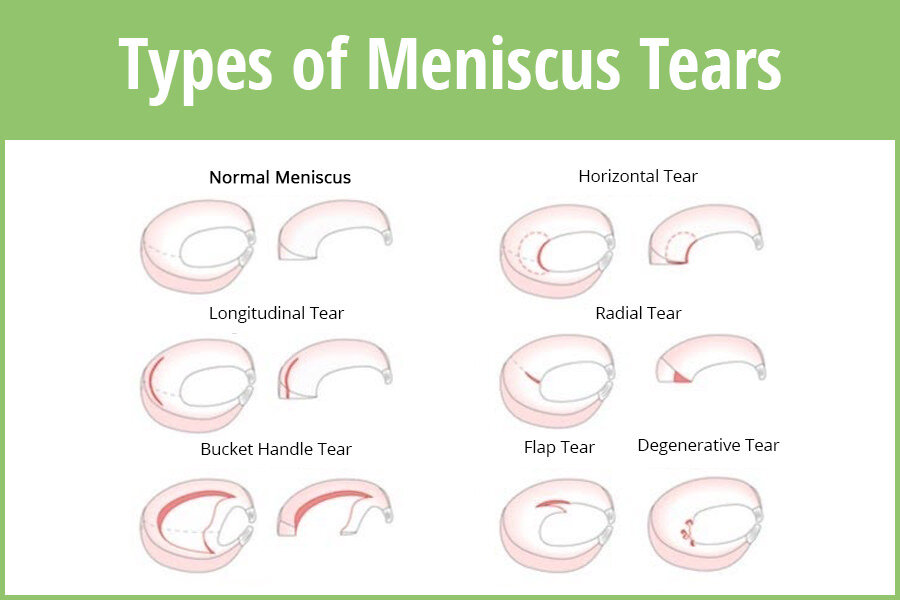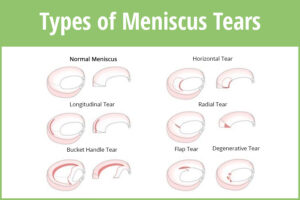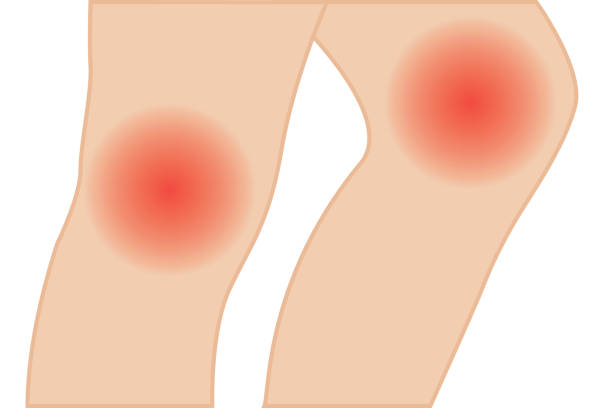



Meniscus tears have six distinct types of, each impacting the knee’s C-shaped cartilage in unique ways. These tear types include radial, intrasubstance, horizontal, flap, complex, and bucket-handle tears. The specific part of the meniscus affected, the patterns observed, and the level of complexity vary among these tear types. The choice of treatment for a meniscus tear is contingent on factors such as the tear type, the individual’s age, the response to non-surgical treatments, and the presence of any additional damage to the knee beyond the torn meniscus.
Seeking guidance from healthcare professionals is crucial for determining the most appropriate course of action based on the specific characteristics of the meniscus tear and the individual’s overall health.
This articles describes each of the types of meniscus tears and how they are treated.
Radial Tear
The most frequently encountered form of meniscus tear is the radial tear, occurring within the avascular zone of the meniscus—a region devoid of a blood supply. Due to its location, these tears have limited potential for self-healing as there are no red blood cells available for tissue repair. When these tears progress to a point necessitating surgical intervention, the common approach is to utilize arthroscopic surgery to trim out the affected portion of the meniscus, as restoration through natural healing mechanisms is challenging in this avascular zone.
Intrasubstance/Incomplete Tear
Intrasubstance changes, alternatively known as incomplete tears, frequently indicate the initial stages of degenerative alterations in the meniscus. These changes typically result from the cumulative effects of wear and tear and tend to progress over time. Healthcare professionals frequently detect this form of meniscus tear during magnetic resonance imaging (MRI) examinations conducted on individuals in their 20s or 30s. Incomplete and intrasubstance meniscus tears are categorized as “stable” injuries, implying that they generally do not necessitate surgical intervention.
Horizontal Tear
A horizontal tear follows the curved fibers of the meniscus and can occur either in the vascular section near the outer edge, where there is blood flow, or in a more central location.
The healing potential and treatment approach depend on the tear’s location:
- Tears within the vascular section: Repair may be a viable option. Instead of removing the damaged part, a surgeon might opt to sew a horizontally torn meniscus together, preserving its integrity.
- Centrally located horizontal tears: These tears generally do not heal, even with surgical intervention.
Flap Tear
A flap tear in the meniscus represents an uncommon tear pattern where a portion of the cartilage peels back and may become lodged in the joint, resulting in a “catch” or locking sensation. When the flap causes the knee to catch, a surgeon typically has the ability to address the issue without needing to remove significant amounts of tissue.
Complex Tear
A complex meniscus tear signifies a combination of tear patterns, commonly involving both radial and horizontal tears.
Due to their intricate nature, surgery to repair complex tears is not typically pursued. However, in exceptional cases, a surgeon may opt to remove certain portions of the torn meniscus while simultaneously repairing other areas of the knee.
Bucket-Handle Tear
A bucket-handle tear occurs at the center of the meniscus. These tears frequently result in the knee becoming immobilized as the torn portion obstructs normal knee motion.
Due to the potential for significant hindrance in knee movement, bucket-handle tears often necessitate prompt surgical intervention to restore the ability for the knee to bend.
Summary
Meniscus tears are injuries that affect the knee’s cartilage, and in some cases, surgical intervention may be necessary. The success of surgery in addressing these tears is contingent on factors such as the tear’s type, its location within the knee, and the presence of blood flow in the affected area. The assessment of these factors plays a crucial role in determining the most effective course of treatment for meniscus tears.
Brace For Meniscus Tears
Wearing a knee brace can ease pain and speed up healing during meniscus tears. At Daphco Medical Equipment, we offer a range of knee braces to support you. Visit our store to find yours today. Medicare beneficiaries can fill out a form for assistance in accessing braces through insurance.
Search Articles
Latest Articles
28th Feb, 24
23rd Feb, 24
20th Feb, 24
15th Feb, 24
13th Feb, 24



 888-616-4156
888-616-4156 



 28th Feb, 24
28th Feb, 24 


